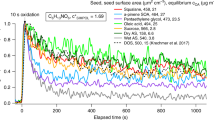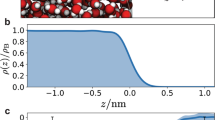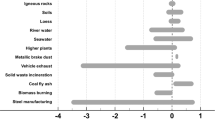Abstract
Nitrous oxide (N2O) is an important trace gas in the atmosphere. It is an active greenhouse gas in the troposphere and it also controls ozone concentration in the stratosphere through nitric oxide production1. One way to trace the geochemical cycle of N2O is by measuring the natural abundance of stable isotopes, namely 15N and 18O (refs 2,3,4,5,6,7,8,9,10,11, 12,13,14,15). Here we report the intramolecular distribution of 15N within the linear NNO molecule, determined by measuring molecular and fragment ions of N2O on a modified mass spectrometer. This revealed a preference for 15N at the central N position, or α-site, within N2O isotopomers (isotope-containing molecules). Moreover, this preference varied significantly throughout the atmosphere. In the troposphere, low α-site preference indicates local emission of N2O from soils and fossil-fuel combustion, each with distinct isotopomer signatures, which then mixes with background N2O. In the stratosphere, on the other hand, loss of N2O is observed as enhanced α-site preference for 15N, due to fractionation during ultraviolet photolysis of N2O. We have constructed an atmospheric mass balance of N2O, incorporating isotopomer abundance, which shows that the intramolecular distribution of 15N is a parameter that has the potential to increase significantly the resolution with which sources and sinks of N2O can be identified and quantified in the atmosphere.
This is a preview of subscription content, access via your institution
Access options
Subscribe to this journal
Receive 51 print issues and online access
$199.00 per year
only $3.90 per issue
Buy this article
- Purchase on Springer Link
- Instant access to full article PDF
Prices may be subject to local taxes which are calculated during checkout



Similar content being viewed by others
References
Houghton, J. T. et al. (eds) Climate Change 1995: The Science of Climate Change (Cambridge University Press, 1995).
Yoshida, N. & Matsuo, S. Nitrogen isotope ratio of atmospheric N2O as a key to the global cycle of N2O. Geochem. J. 17, 231–239 (1983).
Yoshida, N. et al.15N/14N ratio of dissolved N 2O in the eastern tropical Pacific Ocean. Nature 307, 442–444 (1984).
Yoshida, N. 15N-depleted N2O as a product of nitrification. Nature 335, 528–529 ( 1988).
Yoshida, N. et al. Nitrification rates and 15N abundances of N 2O and NO-3 in the western North Pacific. Nature 342, 895–897 (1989).
Yamazaki, T., Yoshida, N., Wada, E. & Matsuo, S. N2O reduction by Azotobacter vinelandii with emphasis on kinetic isotope effects. Plant Cell Physiol. 28, 263– 271 (1987).
Ueda, S., Ogura, N. & Wada, E. Nitrogen isotope ratio of groundwater N2O. Geophys. Res. Lett. 18, 1449–1452 (1991).
Wahlen, M. & Yoshinari, T. Oxygen isotope ratios in N 2O from different environments. Nature 313, 780–782 (1985).
Kim, K. -R. & Craig, H. Two-isotope characterization of N 2O in the Pacific Ocean and constraints on its origin in deep water. Nature 347, 58–61 (1990).
Kim, K. -R. & Craig, H. Nitrogen-15 and oxygen-18 characteristics of nitrous oxide: A global perspective. Science 262 , 1855–1857 (1993).
Inoue, H. Y. & Mook, W. G. Equilibrium and kinetic nitrogen and oxygen isotope fractionations between dissolved and gaseous N2O. Chem. Geol. 113, 135–148 (1994).
Tanaka, N. et al. High precision mass spectrometric analysis of isotopic abundance ratios in nitrous oxide by direct injection of N2O. Int. J. Mass Spectrom. Ion Proc. 142, 163– 175 (1995).
Yoshinari, T. et al. Nitrogen and oxygen isotopic composition of N2O from suboxic waters of the eastern tropical North Pacific and the Arabian Sea –measurement by continuous-flow isotope-ratio monitoring. Mar. Chem. 56, 253–264 ( 1997).
Rahn, T. & Wahlen, M. Stable isotope enrichment in stratospheric nitrous oxide. Science 278, 1776– 1778 (1997).
Dore, J. E., Popp, B. N., Karl, D. M. & Sansone, F. J. A large source of atmospheric nitrous oxide from subtropical North Pacific surface waters. Nature 396, 63–66 (1998).
Thiemens, M. H. & Trogler, W. C. Nylon production: An unknown source of atmospheric nitrous oxide. Science 251, 932–934 (1991).
Cliff, S. S. & Thiemens, M. H. High-precision isotopic determination of the 18O/16O and 17O/16O ratios in nitrous oxide. Anal. Chem. 66 , 2791–2793 (1994).
Cliff, S. S. & Thiemens, M. H. The 18O/16O and 17O/16O ratios in atmospheric nitrous oxide: A mass-independent anomaly. Science 278, 1774–1776 (1997).
Cliff, S. S., Brenninkmeijer, C. A. M. & Thiemens, M. H. First measurement of the 18O/16O and 17O/16O ratios in stratospheric nitrous oxide: A mass independent anomaly. J. Geophys. Res. 104, 16171–16175 (1999).
Rahn, T., Zhang, H., Wahlen, M. & Blake, G. A. Stable isotope fractionation during ultraviolet photolysis of N2O. Geophys. Res. Lett. 25, 4489–4492 (1998).
Yung Y. L. & Miller, C. E. Isotopic fractionation of stratospheric nitrous oxide. Science 278, 1778– 1780 (1997).
Johnston, J. C., Cliff, S. S. & Thiemens, M. H. Measurement of multioxygen isotopic (δ18O and δ17O) fractionation factors in the stratospheric sink reactions of nitrous oxide. J. Geophys. Res. 100 , 16801–116804 (1995).
Holton, J. R. On the global exchange of mass between the stratosphere and troposphere. J. Atmos. Sci. 47, 392–395 (1990).
Kroeze, C, Mosier, A. & Bouwman, L. Closing the global N2O budget: A retrospective analysis 1500–1994. Glob. Biogeochem. Cycles 13, 1–8 (1999).
Zipf, E. C. & Prasad, S. S. Experimental evidence that excited ozone is a source of nitrous oxide. Geophys. Res. Lett. 25, 4333–4336 (1998).
Friedman, L. & Bigeleisen, J. Oxygen and nitrogen isotope effects in the decomposition of ammonium nitrate. J. Chem. Phys. 18, 1325–1331 (1950).
Begun, G. M. & Landau, L. Mass spectra and metastable transitions in isotopic nitrous oxide. J. Chem. Phys. 35, 547–551 (1961).
Richardson, W. S. & Wilson, E. B. Jr The infra-red spectrum of 15N14NO and the force constants of nitrous oxide. J. Chem. Phys. 18, 694 –696 (1950).
Toyoda, S. & Yoshida, N. Determination of nitrogen isotopomers of nitrous oxide on a modified isotope-ratio mass spectrometer. Anal. Chem. 71, 4711–4718 (1999).
Brenninkmeijer, C. A. M. & Röckmann, T. Mass spectrometry of the intra-molecular nitrogen isotope distribution of environmental nitrous oxide using fragment-ion analysis. Rapid Commun. Mass Spectrom. 13, 2028–2033 ( 1999).
Acknowledgements
We thank the members of the balloon launch group of The Institute of Space and Astronautical Science, and the cryogenic sampling group, for cooperation in the stratospheric sampling. We thank M. Thiemens for comments that improved an earlier version of the manuscript.
Author information
Authors and Affiliations
Corresponding author
Rights and permissions
About this article
Cite this article
Yoshida, N., Toyoda, S. Constraining the atmospheric N2O budget from intramolecular site preference in N2O isotopomers. Nature 405, 330–334 (2000). https://doi.org/10.1038/35012558
Received:
Accepted:
Issue Date:
DOI: https://doi.org/10.1038/35012558
This article is cited by
-
Estuarine plastisphere as an overlooked source of N2O production
Nature Communications (2022)
-
Regulation of the electrocatalytic nitrogen cycle based on sequential proton–electron transfer
Nature Catalysis (2022)
-
Nitrogenous fertilizers: impact on environment sustainability, mitigation strategies, and challenges
International Journal of Environmental Science and Technology (2022)
-
The influence of tillage and fertilizer on the flux and source of nitrous oxide with reference to atmospheric variation using laser spectroscopy
Biogeochemistry (2021)
-
Seasonally distinct sources of N2O in acid organic soil drained for agriculture as revealed by N2O isotopomer analysis
Biogeochemistry (2020)
Comments
By submitting a comment you agree to abide by our Terms and Community Guidelines. If you find something abusive or that does not comply with our terms or guidelines please flag it as inappropriate.



